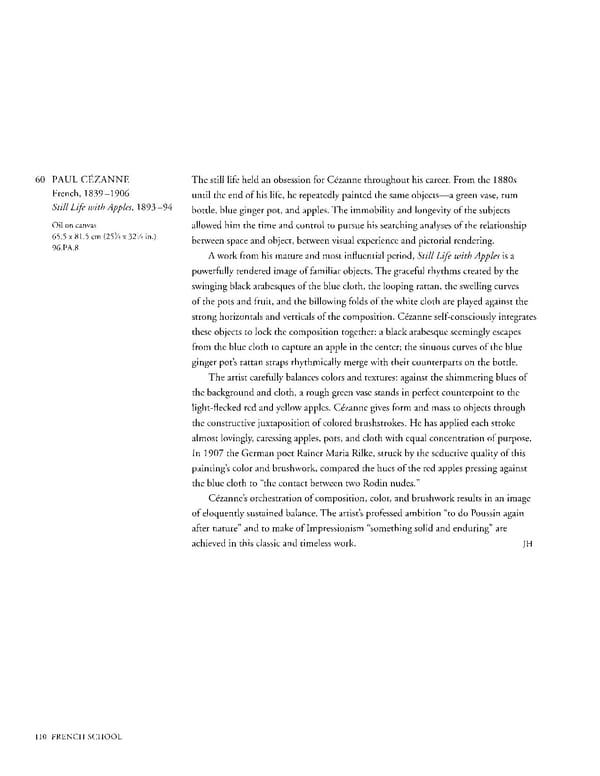60 PAUL CEZANNE The still life held an obsession for Cezanne throughout his career. From the 1880s French, 1839-1906 until the end of his life, he repeatedly painted the same objects—a green vase, rum Still Life with Apples, 1893-94 bottle, blue ginger pot, and apples. The immobility and longevity of the subjects Oil on canvas allowed him the time and control to pursue his searching analyses of the relationship 65.5 x 81.5 cm (25¾ x 32 in.) between space and object, between visual experience and pictorial rendering. 96.PA.8 A work from his mature and most influential period, Still Life with Apples is a powerfully rendered image of familiar objects. The graceful rhythms created by the swinging black arabesques of the blue cloth, the looping rattan, the swelling curves of the pots and fruit, and the billowing folds of the white cloth are played against the strong horizontals and verticals of the composition. Cezanne self-consciously integrates these objects to lock the composition together: a black arabesque seemingly escapes from the blue cloth to capture an apple in the center; the sinuous curves of the blue ginger pot's rattan straps rhythmically merge with their counterparts on the bottle. The artist carefully balances colors and textures: against the shimmering blues of the background and cloth, a rough green vase stands in perfect counterpoint to the light-flecked red and yellow apples. Cezanne gives form and mass to objects through the constructive juxtaposition of colored brushstrokes. He has applied each stroke almost lovingly, caressing apples, pots, and cloth with equal concentration of purpose. In 1907 the German poet Rainer Maria Rilke, struck by the seductive quality of this painting's color and brushwork, compared the hues of the red apples pressing against the blue cloth to "the contact between two Rodin nudes." Cezanne's orchestration of composition, color, and brushwork results in an image of eloquently sustained balance. The artist's professed ambition "to do Poussin again after nature" and to make of Impressionism "something solid and enduring" are achieved in this classic and timeless work. JH 110 FRENCH SCHOOL
 Masterpieces of the Getty Museum: Paintings Page 110 Page 112
Masterpieces of the Getty Museum: Paintings Page 110 Page 112